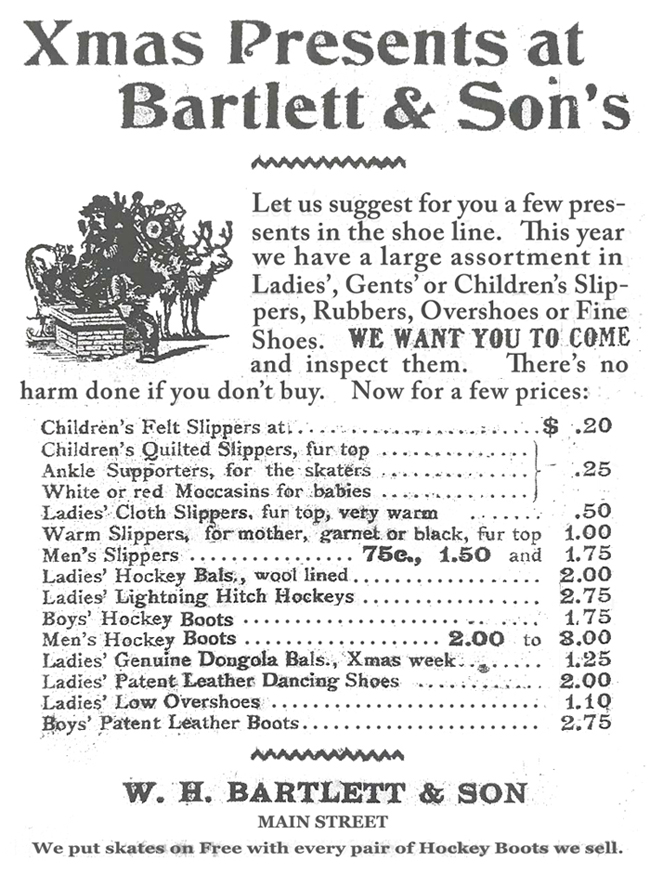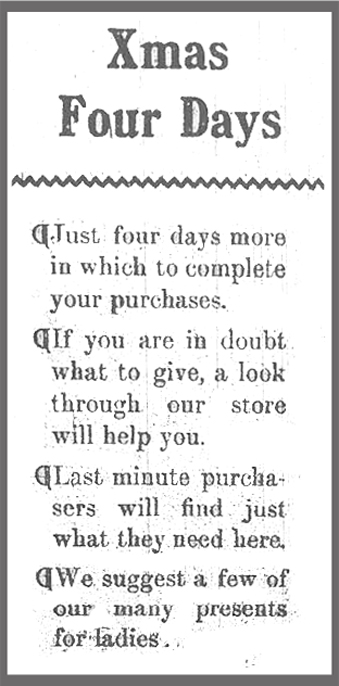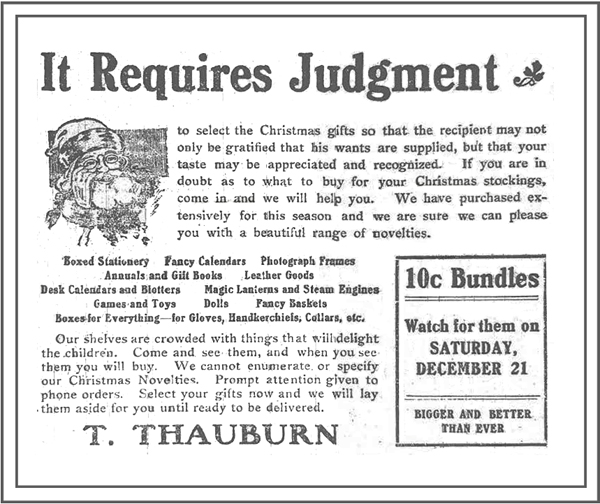
Joyful Old Christmas
‘Tis coming soon, with all its grade,
We long to see each far-off fade;
Give gifts to those whom we hold dear,
And all enjoy the Yuletide cheer.
Would you buy your Christmas presents from a store that advertised in verse? If I lived in Brampton in 1907, I would!
Many of you will know of the hundreds of hours I spent reading past issues of The Conservator, the local Brampton newspaper, while writing my Beneath the Alders series. One aspect of those old papers from which I learned a great deal, was the local advertisements. In this pre-Christmas season, where retailers are advertising their holiday wares from every platform available, I went back and looked at the 1907 pre-Christmas advertisements of seven retailers located on and nearby Brampton’s Main Street. All of the ads ran in the December 19, 1907 issue of The Conservator—the last to be printed before Christmas Day. Five of the retailers sold general merchandise (J.S. Beck, Robinson & Stork, T. Thauburn, T. H. Shields and H. Schooley). Two operated speciality stores: Bartlett & Son, which sold shoes and Rankins, which sold menswear.
How do those ads written long before the evolution of the Madison Avenue ad agencies (Mad Men) hold up to today’s advertising norms? Do they include attractive design elements? Do they identify and solve a consumer’s problem? Do they differentiate their service or product offering from others? Do they include creative, memorable copy?
Attractive design elements
I think we will agree that a good advertisement will have attractive design elements. Beauty however is in the eye of the beholder and it must be said that the beholders of the early 20th century did not have the expectations we do today when it comes to design in advertising. Looking at the first section of today’s Toronto Star—the paper version—the ads are full of phrases and slogans: “Black Friday Pricing Now” or “Discover creativity & community—everywhere”. Very few ads have full sentences, let alone comas. The ads are clearly different in type face and layout than the articles around them. Most have large blocks of white space around black lettered words (or the reverse, black space around white lettered words). Smaller ads without blank spaces use alternating colours to separate phrases. Almost all ads have pictures and most pictures are in colour.
The ads I reviewed from 1907 are nothing like this. There is no space around the words. In all of the ads, there were only two pictures. A cartoon like drawing of the face of Santa Claus in the T. Thauburn ad; a similarly styled drawing of Santa making his way down a chimney, reindeers looking on, appears in the ad of Bartlett & Sons.

The ads have no colour. All text is black on a white background. The design element such as it is, is present in the form of text in different sized fonts some of which is set out in bold face type applied sometimes with more capital letters than are strictly required. No text is italicized. None is underlined. There are few tag lines. Rankins uses “The House that Quality is Building” and “Where the Men’s Wear comes from”. T.S. Shields refers to its store as “The Mammoth”. But the text in the rest of the ads is in sentence form--complete with colons, semi-colons and periods. Nothing about these ads leads to a quick impression. Nothing is particularly attractive—not to these 2lst century eyes.
Promote a solution to a recognized problem
While the ads do not live up to our notion of successful design elements, they do an excellent job in my view, of identifying a problem and setting out a solution. The problems as you will see are not unique to the era. They fall into three categories:
Not enough time
With less than a week until Christmas day, shoppers were running out of time. The Rankins ad begged shoppers for their sake and the sake of the store operator, not to wait until last minute to make their purchases. Robinson & Stork and T. H. Shields, clearly realizing the futility of such a plea, offered evening hours on both the 23rd and 24th. They were more indulgent to last minute shoppers than today’s retailers who generally close early on the 24th.

The perfect gift
Retailers appeared to recognize the desire of customers to purchase perfect gifts for those they loved. As T. Thauburn put it:
It requires Judgement to select the Christmas gifts so that the recipient may not only be gratified that his wants are supplied, but that your taste may be appreciated and recognized.
To meet this need, all of the retailers spoke to their vast array of available merchandise (no supply chain issues then it seems). Many included lists of their available products or types of products. J. S. Beck suggests the ideal present for a lady including: a brush, comb, back comb, bracelet or locket. Rankins lists thirteen different categories of wear including for men: neckwear, robes for lounging or smoking and silk and linen handkerchiefs. Schooley describes his wears in two dozen lines of verse before conceding that he just has too many goods to mention all of them.
No undue pressure
At the same time, the retailers seek to eliminate any perceived requirement to make a purchase while in their stores. Schooley and T. Thauburn welcome shoppers to have a leisurely stroll through their premises. Robinson & Stork, states plainly, there is no obligation to buy and Bartlett echoes the notion saying “there’s no harm done if you don’t buy.”
Differentiation
In terms of a differentiation of service or product offering the ads demonstrate very little. Many sell the same things but T. Thauburn specifically offers prompt attention to phone orders, the opportunity to have selected gifts laid aside and his ad refers to delivery. His ad is the only ad to address such issues.

While four of the ads list prices of products (e.g. handkerchiefs 15c to $1.25; men’s fur lined gloves $2.50; “warm slippers for mother” $1.00; children’s felt slippers 20c), Rankins is the only ad that offers savings. Their prices, the ad says, will save you money.
Creative and memorable copy (or text)
For the most part, the full sentence text of the ads is devoid of creativity. Generally, the ads are simple narratives. As mentioned above, only two ads contain slogans or tag lines. Three of them use the short form “Xmas” rather than Christmas.
But two ads do stand out.
The ad of T.H. Shields, of the “Mammoth”, is quite avant garde in that though it is comprised of four statements only the last statement actually speaks to wares available for sale (a list of which is set out, including examples from their dress goods and small-wares departments). The other three statements within the ad are designed to appeal to the emotions of the buyers, to ally the store, interestingly, with both those who have met with success during the year and to those who have not.
FIRST, we offer congratulations to all who have met with success during the past year – – who have, to some extent at least, attained the objects for which they have laboured and have realized the ambitions in the pursuit of which they have given time and energy.
SECOND, we offer encouragement and renewed hope to those who have met with failures and reverses in the year that is drawing to a close and who though striving hard and with true sincerity, have not received the reward to which their efforts entitled them and who perhaps feel that the year has not been a kind one to them.
The ad then offers their best and sincerest wishes for a Happy Holiday Season. It is the only ad to do so.
But the most creative of the ads is the one of H. Schooley, which appears entirely in verse. The composer is no T.S. Eliot, of course. The ad contains no price list, no hours of operation, no little cartoon. The font is exactly the same as the font in the newspaper article adjacent to it. And yet, having read the rhyming list of offerings, I know that this is the store I’d have gone to first. So here is the entire ode, the first verse of which is also set out above.
Joyful Old Christmas.
‘Tis coming soon, with all its grade,
We long to see each far-off fade;
Give gifts to those whom we hold dear,
And all enjoy the Yuletide cheer.
While walking leisurely about,
Come in and pick your presents out.
We can suit your every taste,
You won’t regret the time you waste.
Raphael Tuck’s grand books and cards,
With rhymes composed by many bards;
Nothing like them in the town,
They are a firm of great renown.
Dogs and cats, good chinaware,
Fine linen boots that kids can’t tear;
Hymn books, prayer books, every creed;
Large printed type old folks can read.
Some rich, fine things in nice glassware,
We can sell you a Teddy Bear;
Mechanical toys of late design,
All kinds of stationery fine.
Wagons, sleighs of iron strong,
To buy them you won’t find it wrong;
Any game you may suggest,
Dolls of all lines, dressed and undressed.
To name all goods was my intention,
But find it too much to mention;
Just come away feeling well,
Third door below Revere Hotel.


To Order Your Copies
of Lynne Golding's Beneath the Alders Series
